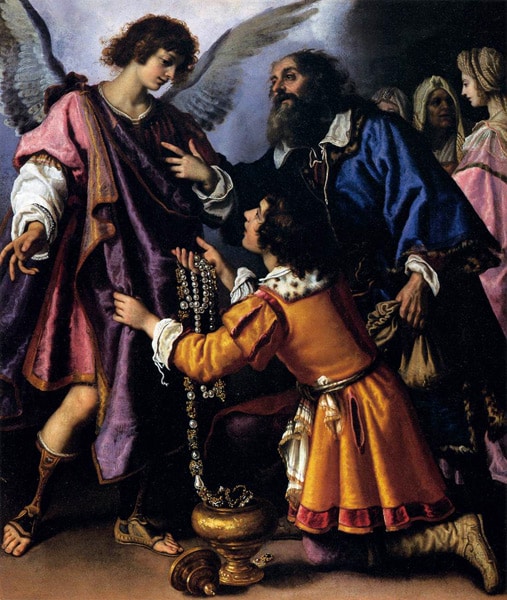Does Saint Raphael Appear in the New Testament? Yes, He Has a Cameo Appearance
Since Protestants don’t have the book of Tobit in their Bibles, if you mention Saint Raphael to them, they’ll likely think that you are referring to the Renaissance painter Raphael, or perhaps that Ninja Turtle of the same name.
Our Protestant friends know about Saint Michael and Saint Gabriel. Both archangels appear by name in the Old Testament and the New Testament. The third member of the angelic triumvirate (or perhaps trium-archangelate) is Saint Raphael who appears only the Deuterocanonical book of Tobit.
Former Catholic priest Father Martin Luther blotted out the book of Tobit from the canonical table of contents and so Protestants don’t have this book or the six Deuterocanonical Bible books removed by Luther.
[callout]If you want to hear my hard words about Martin Luther (in contrast to Padre Pio), click here.[/callout]
Saint Raphael in the Old Testament
In the divinely inspired book of Tobit, the archangel Raphael first disguised in human form as the travel companion of Tobit’s son, Tobias. While in human disguise, Saint Raphael calls himself calling himself “Azarias.” Saint Raphael protects Tobias and even binds the demon Asmodeus in the desert of Egypt. At the end of the story, “Azarias” reveals himself as “Raphael one of the seven, who stand before the Lord” (Tobit 12:15). It’s a great story. By the way, the name Raphael in Hebrew means “God heals,” and so Saint Raphael is associated with physical and spiritual healing.
Saint Raphael in the New Testament
Even advanced students of Sacred Scripture may be surprised to learn that Raphael makes a cameo appearance in the New Testament, as well. Tradition identifies the “healing angel” in John 5 to be Saint Raphael. This is manifest when we see that the Gospel lesson for Saint Raphael’s feast day (in the old calendar Oct 24) is this story from John 5:
an angel of the Lord descended at certain times into the pond; and the water was moved. And he that went down first into the pond after the motion of the water was made whole of whatsoever infirmity he lay under” (Jn 5:1-4)
Is this a slam dunk infallible case? No, but it’s the strong tradition of the Catholic Church that the anonymous angel that stirred the waters for healing was none other than the biblical archangel Raphael from Tobit. After all, Raphael doesn’t like to reveal his name or identity…
Godspeed,
Taylor
Please pass this on to someone who might find it interesting.
PS: Thomas Aquinas only mention Raphael three times in his entire corpus of works. Here are the citations:
- Super Sent., lib. 2 d. 10 q. 1 a. 4
- Summa Theologiae I, q. 112 a. 3
- Super Psalmo 21, n. 27.
[reminder]
What to Watch Next
SHOP THE TAYLOR MARSHALL STORE
Dive Deeper

GET CONFIDENT IN YOUR FAITH
Explore the fascinating world of Catholic teachings with Dr. Marshall. Together you’ll unpack the brilliant answers the Church gives to tough questions about the Faith. The best part: you go at your own pace. Start this exciting journey today.


 >
>



